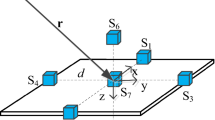Abstract
In order to improve the positioning accuracy and application range of magnetic beacon navigation and positioning system, a method of array rotating magnetic beacon for target positioning is proposed. The plane three-axis cross combination beacon with a cross angle of 60° is placed to generate an artificial magnetic field signal. To reduce the inherent error of the sensor during signal measurement, four flux gate sensors are used at the receiving to form rules tetrahedral magnetic field measurements. On this basis, the characteristic frequency of the measurement signal is extracted using the overall least square method, and based on the gradient tensor positioning algorithm, the mathematical analysis model of the rotating magnetic beacon is derived in detail. In the laboratory environment, NdFeB was selected as the raw material of the magnetic beacon, the rotation frequency of the beacon was set to 20 Hz, and the spatial positioning effect of the combined beacon of the unary and array were compared to verify the practicability of the rotating magnetic beacon positioning method. The results show that the array arrangement of two identical cross-combined permanent magnets will increase the magnetic induction value at the same distance by 1.7 times, and the maximum positioning errors of the beacon and binary array beacon are 3.18 m and 2.46 m in the range of 10 m, the average positioning error is 1.91 m and 1.52 m which verifies the correctness of the proposed method. The use of array rotating combined magnetic beacons as sources provides a new solution for high-precision positioning of targets in the spatial magnetic beacon positioning system.
Access this chapter
Tax calculation will be finalised at checkout
Purchases are for personal use only
Similar content being viewed by others
References
Huan, Sun., Binfeng, Yang., Chi, Li, Run, Wang: Compensation method for double estimation of geomagnetic sensors in geomagnetic navigation. J. Detect. Control 41(05), 90–95 (2019)
Luo, J., Chen, M., Li, J., et al.: An indoor autonomous guided vehicle based on electromagnetic tracking and positioning Ibeacon. In: Proceedings of the 30th China Conference on Control and Decision (5). Liaoning, pp. 1225–1230 (2018)
Yiheng, Zhou., Baoquan, Kou., Peng, Liu., et al.: Force characteristic analysis of a magnetic gravity compensator with annular magnet array for magnetic levitation positioning system. AIP Adv. 8(5), 056706 (2018)
Jia, W.D., Lin, C.S., Sun, Y.H., et al.: Research on magnetic target location method based on a single magnetic gradiometer. Bing Gong Xue bao/acta Armamentarii 38(8), 1572–1577 (2017)
Deng, G., Yao, A., Gong, Z., et al.: Real-time positioning method for horizontal directional drilling based on ground magnetic Beacon. Earth Sci. 42(12), 2336–2344 (2017)
Chaoyue, Liu., Guan, Wang., Hongwei, Xia., et al.: Magnetic Beacon autonomous positioning method based on firefly algorithm. Navig. Position Timing 05, 65–70 (2018)
Zhongyu, G.X., Ruihua, Q., et al.: Digital design of electronic capsule frequency division excitation localization device. Int. J. Biomed. Eng. 41(5),423–427,433 (2018)
Sheinker, A., Ginzburg, B., Salomonski, N., Frumk, L., Kaplan, B.-Z., Moldwin, M.B.: A method for indoor navigation based on magnetic beacons using smartphones and tablets. Measurement 81, 197–209 (2016)
Davis, C.P., Chew, W.C., Tucker.: A null-field method for estimating underground position. Trans. Geosci. Remote Sensing 46(11), 3731–3738 (2008)
Paperno, Eugene., Sasada, Ichiro, Leonovich, Eduard: A new method for magnetic position and orientation tracking. Trans. Mag. 37(4), 1938–1940 (2001)
Dacheng, Z.: Research on Positioning Method Based on Magnetic Beacons and Error Analysis. Harbin Institute of Technology (Harbin) (2016)
Chang, S., Fu, X., Cuicui, Z., et al.: Underwater SLAM method based on magnetic beacons. J. Underwater Unmanned Syst. 27(3), 277–283 (2019)
Zhang, Q.: Research on Magnetic Measurement and Positioning Technology of Connected Wells. Guangdong University of Technology (Guangdong) (2015)
Pedersen, L.B., Rasmussen, T.M.: The gradient tensor of potential field anomalies: Some implications on data collection and data processing of maps. Geophysics 55(12), 1558–1566 (1990)
Wang, S., Zhang, M., Zhang, N., et al.: Calculation and correction of magnetic object positioning error caused by magnetic field gradient tensor measurement. Syst. Eng. Electr. Technol. (English version) 29(03), 16–21 (2018)
Ni, F.: Mathematical methods of electromagnetic field theory. Teach. China Univ. (6), 29
Lifang, Zheng., Wan, Yu., Shaoya, Guan., et al.: A method for expanding the workspace of electromagnetic positioning system. J. Beijing Univ. Aeronaut. Astronaut. 45(10), 1956–1964 (2019)
Pasku, V., Angelis, A.D., Angelis, G.D., et al.: Magnetic field-based positioning systems. IEEE Commun. Surveys Tutorials 19(3), 2003–2017 (2017)
Author information
Authors and Affiliations
Corresponding author
Editor information
Editors and Affiliations
Rights and permissions
Copyright information
© 2022 The Editor(s) (if applicable) and The Author(s), under exclusive license to Springer Nature Singapore Pte Ltd.
About this paper
Cite this paper
Run, W., Bingfeng, Y., Zhen, Z., Hua, G. (2022). Research on Spatial Target Positioning Method Based on Array Rotating Magnetic Beacon. In: Yan, L., Duan, H., Yu, X. (eds) Advances in Guidance, Navigation and Control . Lecture Notes in Electrical Engineering, vol 644. Springer, Singapore. https://doi.org/10.1007/978-981-15-8155-7_21
Download citation
DOI: https://doi.org/10.1007/978-981-15-8155-7_21
Published:
Publisher Name: Springer, Singapore
Print ISBN: 978-981-15-8154-0
Online ISBN: 978-981-15-8155-7
eBook Packages: Intelligent Technologies and RoboticsIntelligent Technologies and Robotics (R0)




